Jai Arjun Singh's Blog
November 22, 2025
15 John Dickson Carr mysteries for your reading pleasure
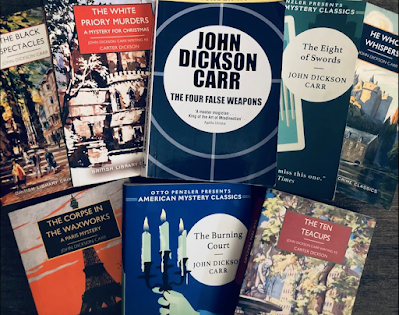 A sequel to the previous post. Here is a listing + tentative ranking of the John Dickson Carr novels I have read so far (around 10 of these in the last two months alone). Many of these I thought brilliant, and none of them has been a clunker. (There have been times when I was underwhelmed by the solution, or thought Carr had gone too far down the rabbit-hole of the overly convoluted or improbable plot – but even in those cases the quality of the writing and the setting up of the puzzle was entertaining enough that the book as a whole worked for me.)
A sequel to the previous post. Here is a listing + tentative ranking of the John Dickson Carr novels I have read so far (around 10 of these in the last two months alone). Many of these I thought brilliant, and none of them has been a clunker. (There have been times when I was underwhelmed by the solution, or thought Carr had gone too far down the rabbit-hole of the overly convoluted or improbable plot – but even in those cases the quality of the writing and the setting up of the puzzle was entertaining enough that the book as a whole worked for me.)Category 1: my absolute favourites so far. Up there with the best Agatha Christies or who-have-you.
– He Who Whispers (wrote a bit about it here)
– The Black Spectacles, a.k.a. The Problem of the Green Capsule
– She Died a Lady (Unlike many Carr fans whose reviews I have read online, I enjoyed the passages of slapstick comedy in this one, including a scene where Sir Henry Merrivale, rattling along noisily in a wheelchair, stirs up the unwelcome attention of every dog in the village centre. I’m surprised that many devoted Carr fans turn their noses up at such humour, especially since it so often balances the darker aspects of a story.)
– The Burning Court (This is one of JDC’s most discussed novels, and among his most divisive… mainly because of a four-page epilogue which seems to not only overturn a perfectly satisfying denouement but also takes the book into territory that is discomfiting for many fans of “fair-play detective fiction”. I loved it, though, and I think the ending can be interpreted in two – if not three – different ways, all of which can work for the open-minded reader.)
– The Four False Weapons (One of those mysteries where, as new revelations and red herrings keep turning up in the book’s final third, you have to laugh out loud at the author’s audacity and confidence. Carr is having *so much* fun here.)
– The Plague Court Murders (A classic locked-room, or locked-hut, situation. With a solution that is inventive but easy to understand and satisfying – though you might wonder how practical it would be to carry out. If you intend to commit a locked-room murder, I mean.)
Note: The first three of the above titles I would have no problem recommending to someone who has never read Carr, is a big Agatha Christie fan, and prefers a relatively cosy/traditional mystery narrative. The last two… it’s probably better that you acquire a taste for Carr’s pyrotechnics first. The Plague Court Murders, for instance, is very heavy on dark atmosphere.
I’m unsure how to categorise The Burning Court along these lines: on the one hand it is a cleanly written book, with a lucid, easy-to-follow plot, a single setting, and a small group of characters; on the other hand, the tightrope it walks between the rational and the supernatural might not work for some readers.
Category 2: not my grade-A favourites, but I love many things about them; highly recommended overall.
– Till Death Do Us Part (A village-mystery Carr that would probably work very well for a Christie fan.)
– The Hollow Man, a.k.a. The Three Coffins – sadly the only Carr novel to have been consistently in print over the decades. Includes the legendary “locked-room lecture” by the harrumphing Dr Gideon Fell.
– The Seat of the Scornful, a.k.a. Death Turns the Tables (This is the one with the indoor swimming-pool scene that I’m convinced influenced a famous scene in the 1942 film Cat People. I would have placed the book higher except that the “how-dunit” or “how-it-happened” is just a little too complicated for my liking.)
– The Ten Teacups, a.k.a. The Peacock Feather Murders (With not one but *two* murder solutions that really stretch plausibility; but it’s very exciting for all that, and there is one moment near the end, involving the discovery of a body – not saying any more – that is as morbidly, eye-poppingly funny as anything else I have read in Golden Age crime-fic.)
– The Corpse in the Waxworks
– It Walks by Night
(These two are among Carr’s first novels, featuring his first series detective Henri Bencolin – and these books, both set in Paris, have a distinctly creepy quality, call it Grand Guignol or Gothic or whatever, that you won’t find in most of his later works.)
Category 3: liked these, but that’s about it.
– The Judas Window (Note: this is the only Carr novel that I have read *online* – and on my laptop, at that, which is not the most fulfilling experience. I mention this because it is one of his most widely admired works, and my relatively subdued feelings about it may have to do with the circumstances of my reading. I am thinking of reading a physical copy soon.)
– The White Priory Murders (As many Carr fans point out, this one has a terrific solution – a simple, uncluttered one – to an “impossible” footprints mystery. But the road to that denouement is sometimes laboured and uninvolving.)
– The Eight of Swords (A wonderfully well-hidden murderer; but again, some of the midsection is a slog to get through.)
I’m sure I’ll be talking Carr again within the next 2-3 months, since I have ordered a few more books, including some that have cult followings…
Rian Johnson on John Dickson Carr
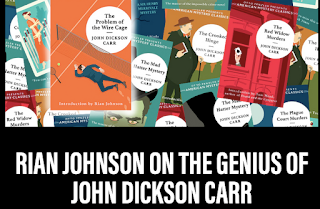 For those of you who know and like Rian Johnson’s work – the Knives Out series, his direction of some major Breaking Bad episodes, etc – I wanted to link to this piece by him, about one of the mystery writers he most admires (who has also lately become one of my favourites).
For those of you who know and like Rian Johnson’s work – the Knives Out series, his direction of some major Breaking Bad episodes, etc – I wanted to link to this piece by him, about one of the mystery writers he most admires (who has also lately become one of my favourites).This is Johnson waxing eloquent on the great John Dickson Carr. It was good to see this because, as mentioned in recent posts here, my reading life in the past few months has largely entailed a discovery/re-discovery of Carr’s work (thanks to some of his novels slowly coming back into print), and I have been staggered by the quality of his output during his peak years: the early 1930s to the mid-40s. One of the big literary injustices I can think of is that while Agatha Christie has been among the bestselling authors of all time worldwide, Carr (whose crime-fiction oeuvre at least for the period mentioned above was every bit as impressive and probably more varied) was almost entirely out of circulation for many decades – with many people who think of themselves as whodunit fans barely knowing his work at all.
I would have preferred to avoid comparisons since these writers have different strengths and weaknesses, but at the present moment I find Carr’s work more stimulating. That said, I also get why Christie’s books travelled better overseas, were more easily adapted to film, and were more accessible to younger readers. (I read most of my Christies for the first time between the ages of 11 and 15; I don’t think I would have found Carr as appealing at that age. This is another reason why I should avoid qualitative comparisons: my reading of these two has been at completely different times in my life, more than 30 years apart.)
Anyway, read the piece. I agree with what Rian Johnson says about Carr’s prose here: “The first quality that blows your hair back in any of Carr’s novels is so fundamental that it’s easy to take it for granted: beyond the plotting or the puzzling, beyond the mystery itself, first and foremost the man is just one hell of a writer. Like walking into a well-put-together room, when you’re in the hands of a good writer you can just feel it…”
Interestingly, the book he is mainly discussing here – The Problem of the Wire Cage – is not rated too highly by serious Carr fans. But I plan to read it soon, and I’ll get this edition which has the Johnson intro.
P.S. I didn’t realise that the 1972 film version of Sleuth included an allusion to the murder in The Problem of the Wire Cage.
P.P.S. here, on a very good Classic Mystery blog, is a comparison of Carr and Christie.
(Coming soon, a listing/ranking of the JDC novels I have read so far)
November 18, 2025
Subarnarekha in a great print (at last)
Super experience at IIC Delhi watching Ritwik Ghatak’s Subarnarekha in a really high-quality print. Subarnarekha, which I watched twice in May this year, was one of my major motivations when writing an essay for Shamya Dasgupta’s big Ghatak anthology (and I began my piece - short passage in the image below - with that marvellous nightclub scene near the end, Abhi Bhattacharya with the crazy head-dress, Bijon Bhattacharya rambling drunkenly on about ambrosia and apsaras). But the print I watched yesterday was easily the best of the lot, and it transformed the film again for me (much as I had already admired it). Too many great images to list, but sharing just a few here.

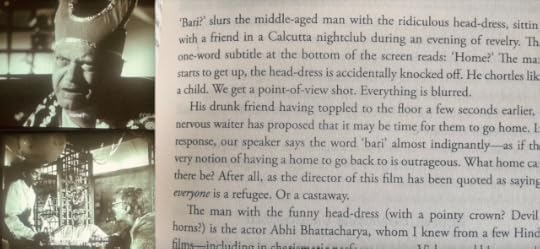

These campus dogs...
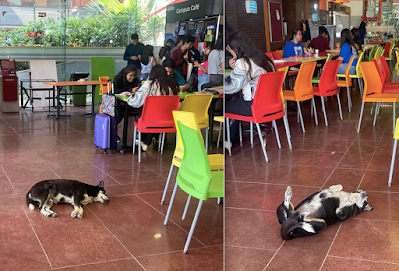 A couple of photos I had taken of the campus dogs at OP Jindal Global University during my teaching stint there in 2022-23. One of the first things I noticed whenever I went there was the attachment that many of the students had to the dogs, and the early lessons in compassion and responsibility they were getting (particularly important in my view for this demographic of privileged young people) in the process of looking after animals, or getting vaccinations and sterilisations done. (Or even - in the case of those who didn’t like the animals - learning to share their spaces with things that made them uncomfortable, an equally important lesson in some contexts.) For me personally, one of the first times that Jindal felt like a warm, welcoming place was when I saw a couple of students (assisted by a teacher) rushing an unwell dog up the stairs to a room where it could be medicated.
A couple of photos I had taken of the campus dogs at OP Jindal Global University during my teaching stint there in 2022-23. One of the first things I noticed whenever I went there was the attachment that many of the students had to the dogs, and the early lessons in compassion and responsibility they were getting (particularly important in my view for this demographic of privileged young people) in the process of looking after animals, or getting vaccinations and sterilisations done. (Or even - in the case of those who didn’t like the animals - learning to share their spaces with things that made them uncomfortable, an equally important lesson in some contexts.) For me personally, one of the first times that Jindal felt like a warm, welcoming place was when I saw a couple of students (assisted by a teacher) rushing an unwell dog up the stairs to a room where it could be medicated.During my time there, I also had a few chats with students who were dealing with anxiety issues, along a spectrum from general everyday deadline stress to pronounced bouts of depression. Completely understandable if you’re an undergrad living and studying in a high-achievers’ environment like this (or just a sensitive young person, period). So I haven’t been surprised at all to see some of the recent messages - on Instagram and elsewhere - from current students, talking about how the dogs’ presence has a calming and focusing effect on them. (For those of us who know what it’s like to form powerful inter-species bonds, this sort of thing is a no-brainer anyway.)
 Amidst the recent instances of animal-care groups in educational institutions sending out official letters asking for their (sterilised, vaccinated) campus dogs not to be taken away, it has been very distressing to read about the stance of the Jindal University administration, refusing to speak with protesting students on this issue. As always, one hopes that some common sense and compassion prevails. But for the situation to come to this, that too with a harsh winter approaching and with the real possibility that docile and well-integrated dogs may be dumped just about anywhere around Sonipat/Haryana with no accountability or tracking… this is horrendous if you have any idea about the potential suffering involved. Anyone who has suggestions - or better yet, concrete help to offer in terms of boarding or fostering possibilities for the more vulnerable JGU dogs - please get in touch and I’ll pass the word on…
Amidst the recent instances of animal-care groups in educational institutions sending out official letters asking for their (sterilised, vaccinated) campus dogs not to be taken away, it has been very distressing to read about the stance of the Jindal University administration, refusing to speak with protesting students on this issue. As always, one hopes that some common sense and compassion prevails. But for the situation to come to this, that too with a harsh winter approaching and with the real possibility that docile and well-integrated dogs may be dumped just about anywhere around Sonipat/Haryana with no accountability or tracking… this is horrendous if you have any idea about the potential suffering involved. Anyone who has suggestions - or better yet, concrete help to offer in terms of boarding or fostering possibilities for the more vulnerable JGU dogs - please get in touch and I’ll pass the word on…
November 15, 2025
To bee or not to bee? A lost dog, firecracker psychos, Bugonia, and the joys of misanthropy
(I wrote last month about my harrowing Diwali-week search for my lost building dog. Couldn’t resist letting off some steam by writing an Economic Times column around it too. Here it is.
Also... see the second image below for my Sherlock Holmes avatar, created by ET's friendly resident robots)
-----------------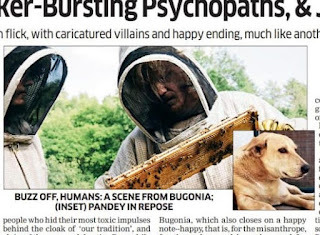 It was my third visit in two days to this unfamiliar colony – including one that had extended till midnight, and another very early the next morning. A space eight kilometres from my home, and from his – a space he had somehow arrived at in disoriented terror as the sounds of firecrackers exploded all around him. I was searching desperately, based on just one sighting mentioned on an animal-care group, and slender hope. Fatigued and demoralised at the sight of other lost dogs running helter-skelter on the roads (occasionally turning back to approach me, since they were looking for friendly humans), I was about to head home when the call came.
It was my third visit in two days to this unfamiliar colony – including one that had extended till midnight, and another very early the next morning. A space eight kilometres from my home, and from his – a space he had somehow arrived at in disoriented terror as the sounds of firecrackers exploded all around him. I was searching desperately, based on just one sighting mentioned on an animal-care group, and slender hope. Fatigued and demoralised at the sight of other lost dogs running helter-skelter on the roads (occasionally turning back to approach me, since they were looking for friendly humans), I was about to head home when the call came.
It was from a local dog-walker whom I had just happened to run into an hour earlier, shown a photo to and left my number with. He had seen my Pandey, one of countless victims of the noise terrorism of the past month; could I come quickly, he said. Heart pounding (because I knew how fast this particular dog could vanish when nervous), I got there just in time. Pandey ji whined accusatorily when he saw me, as if all this had been my fault. The wounds on his paws may have prevented him from going further afield, in which case I would probably never have seen him again. Small mercies. 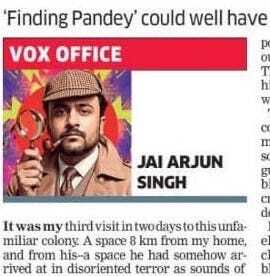 This story may not seem to belong in a film column, but my lost-dog search had elements of popular cinema: drama, tragedy, some unintentional comedy – with spots of guilt and recrimination, hope rising and ebbing, two good Samaritans encountered at crucial moments, and an emotional reunion deserving a Hans Zimmer score.
This story may not seem to belong in a film column, but my lost-dog search had elements of popular cinema: drama, tragedy, some unintentional comedy – with spots of guilt and recrimination, hope rising and ebbing, two good Samaritans encountered at crucial moments, and an emotional reunion deserving a Hans Zimmer score.
It could so easily have been something else instead: an “arty”, non-narrative film with no clear beginning or end; no closure, only bleakness. But this was mainstream, a box-office smash full of action. And loud bombs too, spread over many evenings. Along with caricatured villains who had mwahaha-d callously at me – and encouraged their children to laugh too – when I confronted them a full ten days before Diwali and asked them not to burst so many loud fireworks; tried to tell them about the hyper-sensitive hearing of the sentient creatures who shared our spaces. These were people who hid their most toxic impulses behind the cloak of “our tradition”, and claimed they were celebrating Rama while behaving like the worst of Ravana.
Anyway, for Pandey, this was a happy ending. And a few days after this, I was watching Yorgos Lanthimos’s brilliant new film Bugonia, which also closes on a happy note – happy, I hasten to clarify, for the misanthrope, for the endangered honeybee, and for many other animals across the earth. It’s a marvellous sequence, scored to the plaintive “Where Have All the Flowers Gone” (the Marlene Dietrich version) – the effect is comparable to watching parts of the great animated film Flow, or the ending of Dr Strangelove, where Vera-Lynn’s lovely voice sings “We’ll Meet Again” over images of mushroom clouds bedecking the planet.
What I have written here might be deemed a spoiler for Bugonia, but the joys of this film (if it works for you, that is) lie in many other places, not just in its ending. This story about two men who abduct a CEO, believing she is a malevolent alien, has Emma Stone and Jesse Plemons displaying a Buster Keaton-worthy talent for deadpan humour in utterly absurd situations. It has the controlled lunacy that marked some of Lanthimos’s earlier work, including Kinds of Kindness (which also featured Jesse Plemons and Emma Stone in a story where the former believes the latter is something other than human) and Poor Things.
To reduce a zany film like Bugonia to a “message movie” would be a boring thing to do: Lanthimos’s universe resists such classifications and takeaways. But our responses to films, especially controversial or off-kilter films, can depend on our state of mind at the time. When I watched this one, I had just come off those hellish firecracker days when I was even more of a people-hater than usual; in ugly confrontations, trying to respond to sub-humans who coolly informed me that “our children’s pleasure is more important than animals”.
The last minutes of Bugonia – a tapestry of humans frozen in the middle of mundane actions, including religious ones – were therapeutic, because they allowed me to live out a personal fantasy I always re-live during the Diwali month: that some of the worst offenders in our colony would have a vagrant bomb explode on their hand or in their face as they were lighting it. Judge me for that if you like. Pandey and countless others like him would approve. So would Bugonia’s honeybees.
November 14, 2025
Suchitra brother-zones Dev: watching Bambai ka Babu, and a Raj Khosla tribute
“Mujhe behen ka pyaar nahin chahiye, mujhe aurat ka pyaar chahiye” - Dev Anand to Suchitra Sen in Bambai ka Babu. The timeless lament of every ardent young man, one supposes. But the line has a very specific resonance in this film, with its daring plot point of a man falling in love with the woman whose brother he has been masquerading as.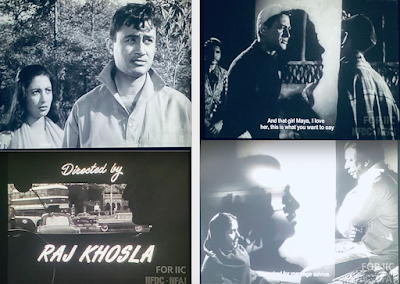 Bambai ka Babu was screened in an excellent restored print at India International Centre yesterday - part of a Raj Khosla tribute in his centenary year - and I thought it was splendid. So well shot by Jal Mistry, with some very notable use of dissolves. Also the way in which the shadowy noir aesthetic is used initially for the crime/impersonation plot, but more effectively later, in the depiction of the fake “brother” struggling with his romantic feelings (and the even more complex arc of the young woman as she slowly discovers the truth).
Bambai ka Babu was screened in an excellent restored print at India International Centre yesterday - part of a Raj Khosla tribute in his centenary year - and I thought it was splendid. So well shot by Jal Mistry, with some very notable use of dissolves. Also the way in which the shadowy noir aesthetic is used initially for the crime/impersonation plot, but more effectively later, in the depiction of the fake “brother” struggling with his romantic feelings (and the even more complex arc of the young woman as she slowly discovers the truth).
I enjoyed the sight of poor Dev being brother-zoned. And has there ever been such sinister background music used in a rakhi scene? A few days earlier, at the same venue, there was a short but informative discussion about Raj Khosla (followed by the screening of the 1969 Do Raaste). The conversation, moderated by Shantanu Ray Chaudhuri and featuring Raj Khosla’s daughter Anita and the veteran Amit Khanna, also touched on Amborish Roychowdhury’s recent book about Khosla. Though I’m an admirer of Amborish’s writing, and just as importantly his work ethic, I haven’t read the book yet, the main reason being that I’d like to watch/revisit some of RK’s films first. (The ones I remember moderately well include Kala Pani, Mera Gaon Mera Desh, Sunny, Prem Kahani - and probably Mera Saaya too. Though as I told a friend at the event, I feel a cognitive dissonance of sorts when I see colour clips from that film: in my head Mera Saaya is firmly a black-and-white work, having watched it on a B&W TV on Doordarshan in the 1980s - and as a noirish story, it feels like it *should* be in black-and-white too.)
A few days earlier, at the same venue, there was a short but informative discussion about Raj Khosla (followed by the screening of the 1969 Do Raaste). The conversation, moderated by Shantanu Ray Chaudhuri and featuring Raj Khosla’s daughter Anita and the veteran Amit Khanna, also touched on Amborish Roychowdhury’s recent book about Khosla. Though I’m an admirer of Amborish’s writing, and just as importantly his work ethic, I haven’t read the book yet, the main reason being that I’d like to watch/revisit some of RK’s films first. (The ones I remember moderately well include Kala Pani, Mera Gaon Mera Desh, Sunny, Prem Kahani - and probably Mera Saaya too. Though as I told a friend at the event, I feel a cognitive dissonance of sorts when I see colour clips from that film: in my head Mera Saaya is firmly a black-and-white work, having watched it on a B&W TV on Doordarshan in the 1980s - and as a noirish story, it feels like it *should* be in black-and-white too.)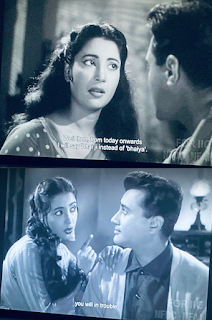 Back to Bambai ka Babu, though, which is Amborish's favourite among Raj Khosla's films. Suchitra making these puppy eyes at her “brother” is everything...
Back to Bambai ka Babu, though, which is Amborish's favourite among Raj Khosla's films. Suchitra making these puppy eyes at her “brother” is everything...
November 10, 2025
Winter beds + the Chaos in a Coupe launch
Two dog-related updates: 1) A big shout-out to Jagjit Singh and Stray Talk India for their thoughtfulness in converting thousands of paint drums into winter beds for community dogs (and making them available free of cost). They have been doing this for a few years now. Yesterday I went to Gurgaon, met Jagjit briefly, and brought back a couple of beds for my dogs downstairs - this is Choti/Mia testing her new bed out.
1) A big shout-out to Jagjit Singh and Stray Talk India for their thoughtfulness in converting thousands of paint drums into winter beds for community dogs (and making them available free of cost). They have been doing this for a few years now. Yesterday I went to Gurgaon, met Jagjit briefly, and brought back a couple of beds for my dogs downstairs - this is Choti/Mia testing her new bed out.
Between the Supreme Court mess and the Diwali/Karva Chauth/Dussehra/Chahath Puja/what have you firecracker “celebrations”, the past few months have been a torrid time for street animals and for their carers (and of course it continues with no end in sight) - with the Delhi chill also starting to set in, some of us are doing what we can to at least keep our (sterilised and vaccinated) animals as safe and comfortable as possible.  (Am also attending online and offline meetings - including the ones by our Stray Buddy group - and getting some solace from the words of wisdom being shared by people who aren’t just “animal activists” but who also understand the complicated workings of inter-species coexistence and harmony very well, and are constantly working to improve things for both human animals and non-human animals. Good to see at least a few educational institutions/colleges sending out official letters expressing support for their campus animals. I hope more such people emerge and continue raising their voices.)
(Am also attending online and offline meetings - including the ones by our Stray Buddy group - and getting some solace from the words of wisdom being shared by people who aren’t just “animal activists” but who also understand the complicated workings of inter-species coexistence and harmony very well, and are constantly working to improve things for both human animals and non-human animals. Good to see at least a few educational institutions/colleges sending out official letters expressing support for their campus animals. I hope more such people emerge and continue raising their voices.) 2) At the launch of Divya Dugar’s book Chaos in a Coupe: Travelling Across India with Three Dogs last week, Hemali Sodhi (who midwived this book with A Suitable Agency) and I continued our time-honoured tradition of posing with calcium bones. Elsewhere, as you can see, Udayan Mitra and I had eyes only for one of the canine chief guests who came up on stage during the book unveiling.
2) At the launch of Divya Dugar’s book Chaos in a Coupe: Travelling Across India with Three Dogs last week, Hemali Sodhi (who midwived this book with A Suitable Agency) and I continued our time-honoured tradition of posing with calcium bones. Elsewhere, as you can see, Udayan Mitra and I had eyes only for one of the canine chief guests who came up on stage during the book unveiling. The event went very nicely: terrific attendance (with some tolerable humans there too), and warm stories by audience members at the end about Divya’s generosity and kindnesses. The book offers plenty of evidence of this. I have followed Divya’s travelling adventures with her indie dogs (plus human family) on Instagram for a few years, and as expected much of the book is about the challenges and exhilarations of such travel – booking coupes in advance, hitchhiking across faraway places with dogs in tow, handling dogs with different personalities and whims (or motion-sickness issues) in a variety of situations. But even for someone like me who has never travelled with dogs at all, there is plenty to relate to. Some of the passages that resonated for me were the ones where Dugar describes how her relationship with indie/street dogs first began in Nizamuddin circa 2008-09 (after not having been interested in animals at all until her early twenties) and how this opened her eyes to a whole new world; about the
The event went very nicely: terrific attendance (with some tolerable humans there too), and warm stories by audience members at the end about Divya’s generosity and kindnesses. The book offers plenty of evidence of this. I have followed Divya’s travelling adventures with her indie dogs (plus human family) on Instagram for a few years, and as expected much of the book is about the challenges and exhilarations of such travel – booking coupes in advance, hitchhiking across faraway places with dogs in tow, handling dogs with different personalities and whims (or motion-sickness issues) in a variety of situations. But even for someone like me who has never travelled with dogs at all, there is plenty to relate to. Some of the passages that resonated for me were the ones where Dugar describes how her relationship with indie/street dogs first began in Nizamuddin circa 2008-09 (after not having been interested in animals at all until her early twenties) and how this opened her eyes to a whole new world; about the 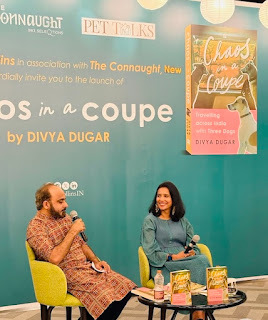 complications, heartaches and worries involved in gradually taking on responsibility for sentient creatures that aren’t fully yours (something that I wrote about in my “Part-Time Dogs” essay for Hemali’s The Book of Dog). This is particularly relevant in the stories about how her Tigress and Pari, initially street dogs, ended up being adopted and turned into full-fledged house kids; one of the book’s loveliest passages is the one about Pari’s first night in this new capacity.
complications, heartaches and worries involved in gradually taking on responsibility for sentient creatures that aren’t fully yours (something that I wrote about in my “Part-Time Dogs” essay for Hemali’s The Book of Dog). This is particularly relevant in the stories about how her Tigress and Pari, initially street dogs, ended up being adopted and turned into full-fledged house kids; one of the book’s loveliest passages is the one about Pari’s first night in this new capacity.
Please look out for the book - as well as the Chaos in a Coupe Instagram page…
November 4, 2025
Some quick gushing about Bugonia
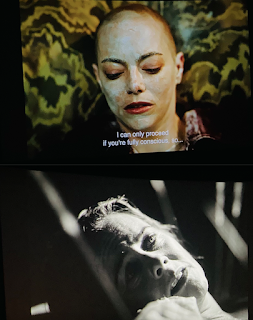 Two stony women in Yorgos Lanthimos’s new film
Bugonia
. (Emma + Alicia Silver) Stone.
Two stony women in Yorgos Lanthimos’s new film
Bugonia
. (Emma + Alicia Silver) Stone.Hadn't been to a hall to watch a film in a few weeks, and this was well worth it. I loved Bugonia (as with everything by Lanthimos, you have to be prepared for some madness). It's eerie and claustrophobic - with many tight closeups, especially in the first half - but often very funny too, in that cold detached way. With some good bee scenes, and a great humming soundtrack to go with them.
And the last five minutes... among the loveliest closing sequences I have seen. (Though you might need to be a certified misanthrope to agree with this assessment.) That ending also incongruously uses a breezy song (“Where Have all the Flowers Gone”, the Marlene Dietrich version), much like Dr Strangelove did with “We’ll Meet Again”.
Overall: this film persuasively makes the point that anyone who thinks Earth, our pale blue dot, can be saved must be mentally ill. Lanthimos’s sensibility, and his coolly misanthropic tone, continues to work very well for me at most times (though Bugonia is almost a sentimental film by his standards - Jesse Plemons's performance is very effective in that regard).
P.S. I wrote a bit about Poor Things in this 2023-Oscars piece, and need to watch Kinds of Kindness, which I had forgotten about.
November 2, 2025
Oysters, snails, and a most satisfying quiz win
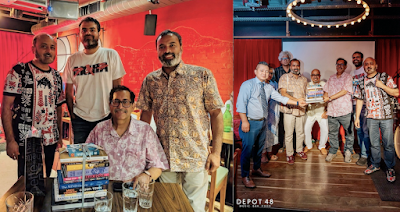 At a world-cinema-themed quiz conducted last month by whysoQrious (Adittya Nath Mubaiyi and Mudita Chauhan-Mubayi) at Depot48, Greater Kailash-2, our team… won. This was certainly a first for me (not that I have much of a history in quizzing; mainly just attending a few of these informal monthly quizzes over the past two or three years). And the win was thanks largely to the heavy-lifting done by the taciturn Uday Bhatia (his first appearance at one of these) and quizzing veteran Tathagata Chatterjee.
At a world-cinema-themed quiz conducted last month by whysoQrious (Adittya Nath Mubaiyi and Mudita Chauhan-Mubayi) at Depot48, Greater Kailash-2, our team… won. This was certainly a first for me (not that I have much of a history in quizzing; mainly just attending a few of these informal monthly quizzes over the past two or three years). And the win was thanks largely to the heavy-lifting done by the taciturn Uday Bhatia (his first appearance at one of these) and quizzing veteran Tathagata Chatterjee.Nikhil Kumar and I – the other two participants – were mostly content to be spectators, but the final, tie-breaking question was one that it might be said I had prepared for over 34 years. It involved Spartacus and the famously censored snails-and-oysters scene between Laurence Olivier and Tony Curtis, which I had read trivia about in cinema books during my nascent obsession with Old Hollywood in the early 1990s. (I watched Spartacus for the first time in mid-1991 - it was one of my major entry points into Old Hollywood, as mentioned in this 20-year-old post - but the version I saw then didn't have the snails-and-oysters line. I probably first heard about the story from Kirk Douglas's memoir.)
Anyway, as Nirupama Kotru (a former team-members, not with us last night but hovering about
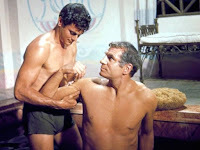 in spirit like a relentless kotri bird) pointed out, the Spartacus question was my Slumdog Millionaire moment.
in spirit like a relentless kotri bird) pointed out, the Spartacus question was my Slumdog Millionaire moment. P.S. the team name, suggested by my punster friend Tipu, was “Jaani Hall” or “Jaani All” (a tribute to Diane Keaton, who had died the previous day, and Annie Hall). The Bengali “Jaani” turned out to be prophetic too - since the very first question, which Tathagata gleefully pounced on, involved Ray’s Charulata. (And a later question featured Ray’s short film Pikoo.)
P.P.S. Tathagata has an entertaining public post on FB about the evening, which you can read here.
The Ritwik Ghatak online discussion
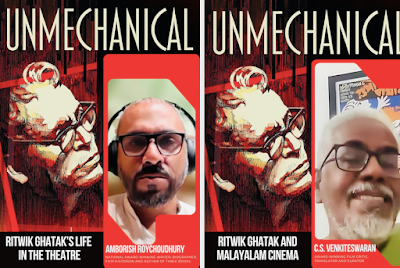 Ritwik Ghatak’s birth centenary is this month. Last week a few dozen of us had a wide-ranging Zoom discussion about him, and about my friend Shamya Dasgupta’s new anthology, which I mentioned here. Four of the contributors to the book – Shamya, Amborish Roychoudhury, CS Venkiteswaran, and myself – were present, as you can see from these images (all bearded men - I call it a WolfManel), but other participants weighed in too with thoughts about Ghatak and his work and influence. As did the Westland publisher, Karthika VK.
Ritwik Ghatak’s birth centenary is this month. Last week a few dozen of us had a wide-ranging Zoom discussion about him, and about my friend Shamya Dasgupta’s new anthology, which I mentioned here. Four of the contributors to the book – Shamya, Amborish Roychoudhury, CS Venkiteswaran, and myself – were present, as you can see from these images (all bearded men - I call it a WolfManel), but other participants weighed in too with thoughts about Ghatak and his work and influence. As did the Westland publisher, Karthika VK.A few of the talking points included: how a viewer can feel differently about Ritwik Ghatak over time (with personal growth and of course with the availability of better prints/subtitles); a political move in his seemingly least “political” film Bari Theke Paliye; Keralite attitudes to Ghatak; the film teacher who claimed not to care for cinema as a form; humour, playfulness and music in Ghatak’s cinema.
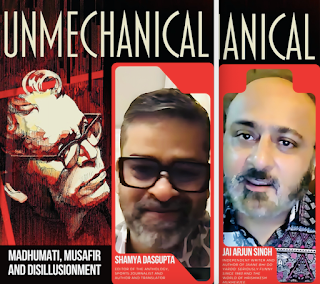 Anyone who would like the link to the Zoom recording, please email me (jaiarjun@gmail.com) and I’ll send it across.
Anyone who would like the link to the Zoom recording, please email me (jaiarjun@gmail.com) and I’ll send it across.(And thanks to Shillpi Singh for these creatives and for pushing us to keep sharing information about the book.)
Jai Arjun Singh's Blog
- Jai Arjun Singh's profile
- 11 followers



